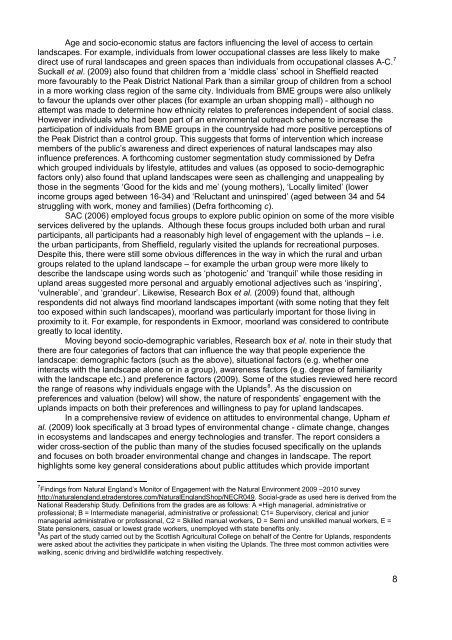Public Attitudes and Preferences for Upland Landscapes - Defra
Public Attitudes and Preferences for Upland Landscapes - Defra
Public Attitudes and Preferences for Upland Landscapes - Defra
You also want an ePaper? Increase the reach of your titles
YUMPU automatically turns print PDFs into web optimized ePapers that Google loves.
Age <strong>and</strong> socio-economic status are factors influencing the level of access to certain<br />
l<strong>and</strong>scapes. For example, individuals from lower occupational classes are less likely to make<br />
direct use of rural l<strong>and</strong>scapes <strong>and</strong> green spaces than individuals from occupational classes A-C. 7<br />
Suckall et al. (2009) also found that children from a ‘middle class’ school in Sheffield reacted<br />
more favourably to the Peak District National Park than a similar group of children from a school<br />
in a more working class region of the same city. Individuals from BME groups were also unlikely<br />
to favour the upl<strong>and</strong>s over other places (<strong>for</strong> example an urban shopping mall) - although no<br />
attempt was made to determine how ethnicity relates to preferences independent of social class.<br />
However individuals who had been part of an environmental outreach scheme to increase the<br />
participation of individuals from BME groups in the countryside had more positive perceptions of<br />
the Peak District than a control group. This suggests that <strong>for</strong>ms of intervention which increase<br />
members of the public’s awareness <strong>and</strong> direct experiences of natural l<strong>and</strong>scapes may also<br />
influence preferences. A <strong>for</strong>thcoming customer segmentation study commissioned by <strong>Defra</strong><br />
which grouped individuals by lifestyle, attitudes <strong>and</strong> values (as opposed to socio-demographic<br />
factors only) also found that upl<strong>and</strong> l<strong>and</strong>scapes were seen as challenging <strong>and</strong> unappealing by<br />
those in the segments ‘Good <strong>for</strong> the kids <strong>and</strong> me’ (young mothers), ‘Locally limited’ (lower<br />
income groups aged between 16-34) <strong>and</strong> ‘Reluctant <strong>and</strong> uninspired’ (aged between 34 <strong>and</strong> 54<br />
struggling with work, money <strong>and</strong> families) (<strong>Defra</strong> <strong>for</strong>thcoming c).<br />
SAC (2006) employed focus groups to explore public opinion on some of the more visible<br />
services delivered by the upl<strong>and</strong>s. Although these focus groups included both urban <strong>and</strong> rural<br />
participants, all participants had a reasonably high level of engagement with the upl<strong>and</strong>s – i.e.<br />
the urban participants, from Sheffield, regularly visited the upl<strong>and</strong>s <strong>for</strong> recreational purposes.<br />
Despite this, there were still some obvious differences in the way in which the rural <strong>and</strong> urban<br />
groups related to the upl<strong>and</strong> l<strong>and</strong>scape – <strong>for</strong> example the urban group were more likely to<br />
describe the l<strong>and</strong>scape using words such as ‘photogenic’ <strong>and</strong> ‘tranquil’ while those residing in<br />
upl<strong>and</strong> areas suggested more personal <strong>and</strong> arguably emotional adjectives such as ‘inspiring’,<br />
‘vulnerable’, <strong>and</strong> ‘gr<strong>and</strong>eur’. Likewise, Research Box et al. (2009) found that, although<br />
respondents did not always find moorl<strong>and</strong> l<strong>and</strong>scapes important (with some noting that they felt<br />
too exposed within such l<strong>and</strong>scapes), moorl<strong>and</strong> was particularly important <strong>for</strong> those living in<br />
proximity to it. For example, <strong>for</strong> respondents in Exmoor, moorl<strong>and</strong> was considered to contribute<br />
greatly to local identity.<br />
Moving beyond socio-demographic variables, Research box et al. note in their study that<br />
there are four categories of factors that can influence the way that people experience the<br />
l<strong>and</strong>scape: demographic factors (such as the above), situational factors (e.g. whether one<br />
interacts with the l<strong>and</strong>scape alone or in a group), awareness factors (e.g. degree of familiarity<br />
with the l<strong>and</strong>scape etc.) <strong>and</strong> preference factors (2009). Some of the studies reviewed here record<br />
the range of reasons why individuals engage with the Upl<strong>and</strong>s 8 . As the discussion on<br />
preferences <strong>and</strong> valuation (below) will show, the nature of respondents’ engagement with the<br />
upl<strong>and</strong>s impacts on both their preferences <strong>and</strong> willingness to pay <strong>for</strong> upl<strong>and</strong> l<strong>and</strong>scapes.<br />
In a comprehensive review of evidence on attitudes to environmental change, Upham et<br />
al. (2009) look specifically at 3 broad types of environmental change - climate change, changes<br />
in ecosystems <strong>and</strong> l<strong>and</strong>scapes <strong>and</strong> energy technologies <strong>and</strong> transfer. The report considers a<br />
wider cross-section of the public than many of the studies focused specifically on the upl<strong>and</strong>s<br />
<strong>and</strong> focuses on both broader environmental change <strong>and</strong> changes in l<strong>and</strong>scape. The report<br />
highlights some key general considerations about public attitudes which provide important<br />
7 Findings from Natural Engl<strong>and</strong>’s Monitor of Engagement with the Natural Environment 2009 –2010 survey<br />
http://naturalengl<strong>and</strong>.etraderstores.com/NaturalEngl<strong>and</strong>Shop/NECR049. Social-grade as used here is derived from the<br />
National Readership Study. Definitions from the grades are as follows: A =High managerial, administrative or<br />
professional; B = Intermediate managerial, administrative or professional; C1= Supervisory, clerical <strong>and</strong> junior<br />
managerial administrative or professional, C2 = Skilled manual workers, D = Semi <strong>and</strong> unskilled manual workers, E =<br />
State pensioners, casual or lowest grade workers, unemployed with state benefits only.<br />
8 As part of the study carried out by the Scottish Agricultural College on behalf of the Centre <strong>for</strong> Upl<strong>and</strong>s, respondents<br />
were asked about the activities they participate in when visiting the Upl<strong>and</strong>s. The three most common activities were<br />
walking, scenic driving <strong>and</strong> bird/wildlife watching respectively.<br />
8
















